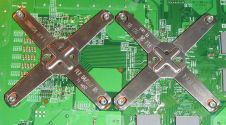X-Clamp
An X-Clamp is part of the cooling system of an Xbox 360 console in that the X-Clamp is used to keep the heatsinks pressed to the console's CPU and GPU. While the heatsinks are secured to the inner shell of the console with screws, the X-Clamps will continue to hold the heatsinks to the chips when the motherboard is removed from the Xbox 360 casing entirely, until the X-Clamps are clipped off.

The X-Clamps are clearly visible on the underside of the board. They are not bolted to the heatsink in any way and can be removed quite easily with a small flat-head screw driver. There is some debate over potentially negative effects of the X-Clamps applied to the Xbox 360 chips, particularly in the case of the GPU. The Xbox 360 GPU produces quite a large amount of heat, particularly in early versions of the console hardware.
Some of the first Xbox 360 consoles were found to be poorly cooled, largely due to inadequate thermal compound making a connection between the CPU/GPU and the heatsinks. This is evident when an Xbox 360's internal fans get faster in a short space of time while the console is sitting more or less idle on the Dashboard.
Some major GPU-related problems with the Xbox 360 consoles, such as the RROD error or E74 error, might have come at least partially from the affect of so much heat on the X-Clamp. The theory is that the heat causes the X-Clamp to actually warp/bend the motherboard under the GPU, causing minute cracks and breakages in solder joints. This potential cause is backed up by hundreds, maybe thousands of claims from users that applied so called "X-Clamp Replacement" fixes to their consoles that were successful in ridding it of the RROD or E74 errors.
However, even though this potential cause for the problem has been online for years, all Xbox 360 console hardware revisions include the X-Clamps. While the console overall has a very high failure rate (varies wildly based on the research), the most recent hardware revisions (2010) are thought to be almost completely free of the RROD and E74 errors.

